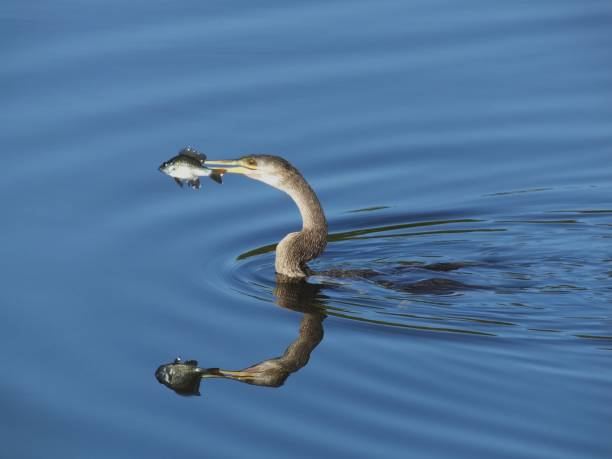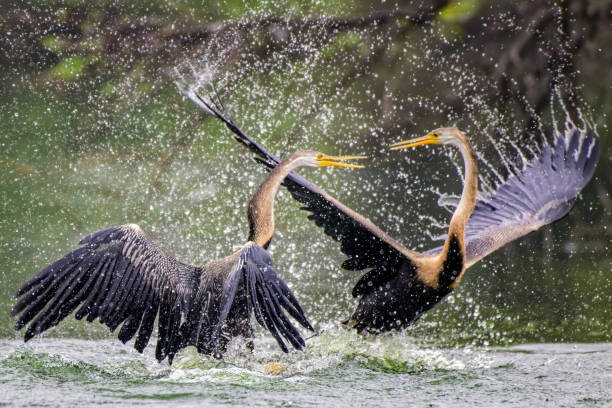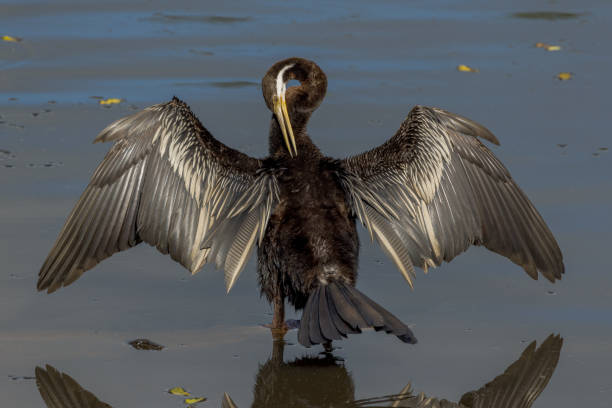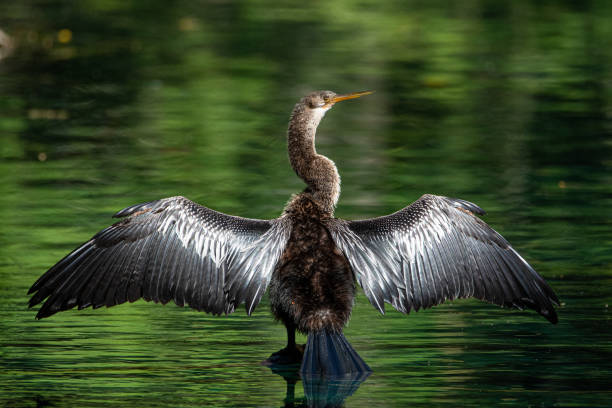Table of Contents
Scientific Classification
| Kingdom | Animalia |
| Phylum | Chordata |
| Class | Aves |
| Order | Suliformes |
| Family | Anhinga anhinga |
| Genus | Anhinga |
| Species | Anhinga anhinga |
| Scientific | Anhinga anhinga |
Description
The Anhinga is a large bird that inhabits aquatic environments. It’s commonly referred to as the “snakebird” due to its long, slender neck, which resembles a snake when it emerges from the water. This bird measures about 35 inches in length and has a wingspan of roughly 46 inches. Anhingas are characterized by their glossy dark feathers, long fan-shaped tails, and sharp, dagger-like beaks, all of which aid in their ability to catch fish. Males typically have darker plumage, while females display a lighter, buff-colored head and neck.
Distribution
Anhingas are mainly located in the warm areas of the Americas. Their range begins in the southeastern United States, particularly in Florida. It extends through Central America and into South America. You can often spot them in tropical and subtropical regions that have abundant freshwater habitats.
Habitat
These birds prefer slow-moving freshwater environments. You can find them in swamps, marshes, lakes, rivers, and coastal lagoons. Anhingas are different from cormorants; while cormorants typically inhabit saltwater, Anhingas favor freshwater. They are often seen in areas rich in vegetation and submerged branches where they can perch.
Diet
Anhingas mainly eat fish, making them primarily piscivores. Along with fish, they sometimes eat amphibians, crustaceans, and aquatic insects.

Behavior
One of the most distinctive behaviors of Anhingas is their unique drying posture. Their feathers do not have waterproofing oils, so they need to spread their wings wide in the sun to dry off after diving. This iconic pose is frequently seen on tree branches, logs, or other perches close to water.
Anhingas are excellent divers. They utilize their webbed feet and streamlined bodies to glide underwater while searching for prey. Unlike ducks or other waterbirds that use their wings, Anhingas rely on their feet for movement.
Lifespan
In the wild, Anhingas typically live for about 10 to 15 years. However, in optimal conditions with minimal predators and an abundance of food, they can survive for even longer.
Reproduction and Life Cycle
Anhingas breed in colonies, often alongside herons, ibises, and egrets. The timing of their breeding season can vary depending on the location, but it typically occurs between March and June.
Males perform displays to attract females, waving their wings and bobbing their heads. Once a pair forms, they build a nest in trees or shrubs close to water, using twigs, leaves, and other plant materials. The female lays between 2 to 5 pale blue eggs, which both parents take turns incubating for about 25 to 30 days.
After hatching, the chicks depend on their parents for food and protection. By the time they reach 6 weeks old, they start to learn how to fly and hunt for themselves, becoming fully fledged at around 8 weeks.

Predators
Anhingas, being aquatic birds, encounter various predators during their lives. Their eggs and young chicks are vulnerable to raccoons, snakes, and larger birds such as hawks and owls. Adult Anhingas can be targeted by alligators, snapping turtles, and larger birds of prey like eagles.
Adaptations
Anhingas possess distinct adaptations that enable them to hunt effectively and thrive in aquatic environments.
Dagger-like Beak: This specialized beak is perfect for spearing fish, allowing them to easily catch slippery prey.
Webbed Feet: Their webbed feet provide strong propulsion in the water, making them agile swimmers.
Non-Waterproof Feathers: Anhingas have feathers that absorb water, which reduces their buoyancy and allows them to stay submerged while hunting. Unlike ducks, their feathers do not repel water.
Sun-Drying Behavior: Lacking waterproof oils, they adopt a drying posture to regain flight efficiency after swimming.
Camouflaged Plumage: Their dark coloration helps them blend into the shadows along rivers and trees, making them less noticeable to predators.
Conservation Status
Conservation Status
The IUCN currently classifies the Anhinga as a Least Concern species, indicating that their populations are not at significant risk globally. Nonetheless, threats such as habitat destruction, water pollution, and human encroachment can still negatively impact them.
Conservation initiatives focus on safeguarding wetland habitats and ensuring clean water. They also monitor population trends to prevent any future declines.
The Anhinga is a distinctive bird, with unique adaptations that set it apart from other waterbirds. Its snake-like form and striking appearance make it a fascinating subject for study and observation. Protecting wetland ecosystems is essential for the continued survival of this remarkable bird for generations to come.



